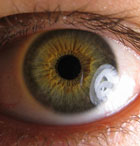New MRI research demonstrates that acupuncture benefits vision by stimulation of an acupuncture point located on the leg. Investigators compared stimulation of acupuncture point GB37 (Guangming, Bright Light) with a non-acupuncture point in close proximity. GB37 elicited complex brain activity in the visual cortex whereas the non-acupuncture control point exhibited a completely different response when measured with MRI equipment. Based on these findings, the researchers postulate that the neural signals elicited by acupuncture point stimulation may reflect important pathways by which acupuncture exerts its therapeutic effects.
 GB37 has been used for the treatment of eye related disorders for over a thousand years. The advent of functional MRI imaging has allowed for researchers to measure the specific regions of the brain activated by acupoint stimulation. Clear evidence from this study demonstrates that GB37 acupuncture needle stimulation activates areas of the brain responsible for vision. Researchers carefully noted that the activation of the visual cortex lasted longer than expected following the acupuncture point stimulation. They also referenced this lasting effect as the “sustained effect of acupuncture” and note that future study designs should take into account acupuncture’s ability to make lasting changes. The researchers note that some studies seek to measure an instant on and off effect rather than measuring the duration of acupuncture’s physiological effects.
GB37 has been used for the treatment of eye related disorders for over a thousand years. The advent of functional MRI imaging has allowed for researchers to measure the specific regions of the brain activated by acupoint stimulation. Clear evidence from this study demonstrates that GB37 acupuncture needle stimulation activates areas of the brain responsible for vision. Researchers carefully noted that the activation of the visual cortex lasted longer than expected following the acupuncture point stimulation. They also referenced this lasting effect as the “sustained effect of acupuncture” and note that future study designs should take into account acupuncture’s ability to make lasting changes. The researchers note that some studies seek to measure an instant on and off effect rather than measuring the duration of acupuncture’s physiological effects.
The researchers note that sham acupuncture controlled studies may mistakenly conclude that non-acupuncture points adjacent to true acupuncture points have similar neurological effects. Although the brain activity varied greatly between the non-acupuncture control point and the stimulation of GB37 in this study, the researchers note that it is the lasting effects of GB37 stimulation which are remarkable. This caveat suggests that even had the sham non-acupuncture point had similar effects on the brain, that the ability of a true acupuncture point to create lasting neural signals is, at the very least, equally important in determining the efficacy of a true acupuncture point.
Treatment of eye disorders with acupuncture is often accomplished with the use of local points, distal points and micro-system points such as auricular acupuncture and scalp acupuncture. This study sought to measure the effects of the distal point GB37. A classic point for the treatment of eye disorders, GB37 is commonly used for the treatment disorders such as opthalmalgia (eyeball pain), night blindness, itchy eyes, impaired vision, headaches, knee pain and atrophy of the lower leg. According to Chinese medicine theory, GB37 is a Luo-Connecting point of the Gall Bladder channel. GB37’s classical acupuncture functions are to regulate the Liver, clear vision, benefit the eyes and to dispel wind-damp pain related conditions. GB37 is 5 cun directly above the tip of the external malleolus on the anterior border of the fibula.
Reference:
Liu, Jixin, Jiaofen Nan, Shiwei Xiong, Guoying Li, Wei Qin, and Jie Tian. "Additional evidence for the sustained effect of acupuncture at the vision-related acupuncture point, GB37." Acupuncture in Medicine (2013).

